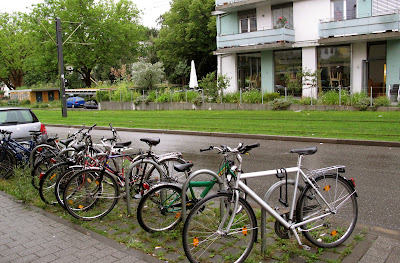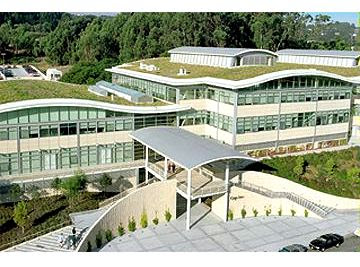Here in the good 'ole United States of America most of us that live in urban areas have the luxury of a sewer system to take care of all that pesky storm water runoff that inevitably happens when H2O falls from the skies.
 Generally speaking property owners are charged for this service via a variety of fees tied to water usage. This method assumes all properties in a service area are created equal and rewards those with poor storm water management strategies with a lower fee than they would be charged if each parcel was assessed individually. This unfairly subsidizes those that pour concrete and divert runoff directly onto their neighbors lot or into the storm drain system. As storm sewer systems are deteriorating in this country it is time to change how we handle run off. One way to begin to change could be to make it more attractive to property owners to install a passive storm water management system in the form of planted or permeable surfaces.
Generally speaking property owners are charged for this service via a variety of fees tied to water usage. This method assumes all properties in a service area are created equal and rewards those with poor storm water management strategies with a lower fee than they would be charged if each parcel was assessed individually. This unfairly subsidizes those that pour concrete and divert runoff directly onto their neighbors lot or into the storm drain system. As storm sewer systems are deteriorating in this country it is time to change how we handle run off. One way to begin to change could be to make it more attractive to property owners to install a passive storm water management system in the form of planted or permeable surfaces.
 Planted surfaces can slow the speed of run off leaving a property and reduce any pollution in the water as it filters through plants and soil. A properly planted green roof, green wall or native plant garden allows you to contribute mightily to your corner of the eco-system. Recently I toured the Vauban neighborhood in Freiberg, Germany during a steady downpour. The law in Germany state that each property owner is responsible for managing any storm water that arrives on their property. In Vauban this is accomplished in several ways; green roofs, lots of permeable surfaces, and landscapes that follow the natural curves of the land are used to capture any run off. I was surprised to see areas in the neighborhood that would normally be paved, planted with a sturdy ground cover. However as we continued to walk through the rain, I realized that there appeared to be no streams of water in a gutter that needed to be jumped as we crossed streets. In fact, there were not really any gutters as we know them to speak of, merely a curb to delineate the road from the walkway. This works!
Planted surfaces can slow the speed of run off leaving a property and reduce any pollution in the water as it filters through plants and soil. A properly planted green roof, green wall or native plant garden allows you to contribute mightily to your corner of the eco-system. Recently I toured the Vauban neighborhood in Freiberg, Germany during a steady downpour. The law in Germany state that each property owner is responsible for managing any storm water that arrives on their property. In Vauban this is accomplished in several ways; green roofs, lots of permeable surfaces, and landscapes that follow the natural curves of the land are used to capture any run off. I was surprised to see areas in the neighborhood that would normally be paved, planted with a sturdy ground cover. However as we continued to walk through the rain, I realized that there appeared to be no streams of water in a gutter that needed to be jumped as we crossed streets. In fact, there were not really any gutters as we know them to speak of, merely a curb to delineate the road from the walkway. This works!

Here in the United States we need to start to change how we think about our land and water management. It would be a start to think about how we can help to manage storm water on our own properties. Eliminating slabs of solid concrete, native plant gardens, and green roofs are several easy ways to do this. (well the green roof is not so easy, but once installed, it's very easy) Not only does this work to help absorb storm water, the plants will work to offset CO2 and will be an attractive contribution to the area. A patio constructed from interlocking or permeable pavers, is not only nicer looking than a slab of concrete, it is a permeable surface that allows water to flow through natural aquifers and into the watershed.


There have been several high profile commercial developments in Northern California that installed a green roof with much fanfare. In 2000 Gap Inc. built an addition to their headquarters campus in San Bruno that featured a green roof whose profile mirrors the surrounding hills. The redesigned California Academy of Sciences features a green roof that not only absorbs almost all storm water that falls on it, but also provides a habitat for native plants and a variety of wildlife. Other features in this particular roof include photovoltaic cells and skylights used to provide natural light as well as cool the building below. We have heard that the new Transbay Terminal building is planned to have a green roof. As we start to see success with commercial projects and fees associated with a deteriorating sewer system, more home owners may be inspired to install this type of roof.
Planting a native garden and eliminating non-permeable surfaces are a more likely choices for those looking to make a difference without major construction. Patio areas can be installed using open cell concrete block with a low, creeping ground cover planted in the cells or with interlocking pavers. Both options allow water to flow through and be absorbed into the ground underneath. Any neighborhood plant nursery should be able to provide a list of native plants for the area as well as being a source of the plants themselves. Ask when the best time to plant is and plan your purchases accordingly. Once established a native plant garden will be a low maintenance way to both stabilize the soil, absorb storm water, and a small refuge for all wildlife, including yourself!
* a thank you to Victor Hugo for his quote...(images all property of author unless otherwise noted.)





No comments:
Post a Comment